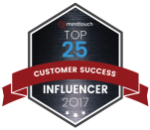The Enlightenment, also known as the “age of reason” and the “age of lights”, “was an intellectual and philosophical movement which dominated the world of ideas in Europe during the 18th century”. The ideas of the Enlightenment, which included liberty, progress, skepticism, and tolerance, led to massive change in how people perceived themselves and especially in relation to their perception of the roles of the monarchy and church. It changed the face of Europe and North America with two massive revolutions.

This concept of upheaval removed the psychological shackles that had persisted at that time. In 1944, philosophers Max Horkheimer and Theodor W. Adorno argued that the “Enlightenment, understood in the widest sense as the advance of thought, has always aimed at liberating human beings from fear and installing them as masters.”
While we’re not seeing governments overthrown today due to this, this reversal in roles is apparent in how people buy and consume products. We’re seeing a new type of enlightenment. These are the enlightened customers.
While we could apply this concept to any product that you’re purchasing today, I want to focus on the area of enterprise software applications. In today’s world of SaaS and cloud computing, the software buying process has completely flipped. Customers will no longer spend exorbitant amounts of money to buy software that may never be used. Customers are no longer locked into the same long term agreements that was forced on buyers of on-premise software. There usually are three or more similar products that customers can now easily purchase that do relatively the same thing. Software can be implemented in weeks when it used to take months or years.
When purchasing enterprise software like a marketing automation system (which I know quite intimately), customers can do most of their research online or they can connect with their network to get the advice they need to make an informed decision. If they do decide to purchase your product, they may demand a trial of your software and other discounts.These customers have extremely high expectations and so they should. They have the power. We are in the age of the enlightened customers and it requires an entirely different approach. Enter Customer Success.
We are in the age of the enlightened customers and it requires an entirely different approach. Enter Customer Success.
The new metrics of Enlightened Customers: LTV and Churn
Lets all get on the same page and start to bring together our enlightened customers, the critical SaaS metrics including lifetime value (LTV) and churn and the importance of Customer Success.
First, let’s provide some perspective on what LTV is and how it relates to churn. LTV is the predicted average lifetime value of your customers. In the example below, if the average revenue per customer is $100 and the customer churn rate is 1%, the LTV is $1000.

Just to provide some additional perspective, IDC has predicted cloud computing to grow from $67B in 2015 to $162B in 2020. That’s a compound annual growth rate of 19%! This will provide more and more power to the customer as companies transition to SaaS products. This is where the SaaS metric Lifetime Value (LTV) becomes critical. Software companies need to focus on creating an amazing experience for their customers and ensure that these customers are achieving their desired outcomes so that they keep customers for the long term (thanks Lincoln Murphy for coining this phrase). This will ensure that they continue to collect revenue from these customers and can look for opportunities to sell additional products and services which further increases the customer’s LTV. Churn becomes the enemy of LTV.

Enlightened customers don’t care about your business or company’s valuation. They care about what they need and if they can’t demonstrate value from your product, they will churn. The average gross dollar churn as reported in the Pacific Crest SaaS survey was 8%. While Customer Success is a function of an entire organization, the Customer Success department must lead the charge against churn. They must face the enlightened customers head on and be their representative.
While Customer Success is a function of an entire organization, the Customer Success department must lead the charge against churn. They must face the enlightened customers head on and be their representative.
Customer Success must devise the strategies and tactics of their respective organizations to ensure that the enlightened customer has the best experience possible and achieves their business outcomes. It’s not an easy job but it can be the most rewarding job on the planet. Are you up for it? Are you ready to take on the enlightened customers? If so, you are in the right place. I will be sharing my experiences within Customer Success to address the new age that we live in.
Contact me to further discuss how I can help you with your Customer Success strategy.
PS – I defined “What is an Enlightened Customer?” a few years ago. While my perspective has changed since then, my passion for the customer hasn’t.




